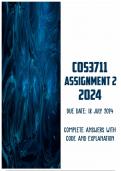Exam (elaborations)
COS3711 Assignment 2 2024 | Due 18 July 2024
- Course
- Institution
Study the following UML class diagram: The UML class diagram is an initial design of classes for a conference registration application. There are three types of registration allowed for the conference: standard registration, student registration and invited guests registration. The standard reg...
[Show more]



